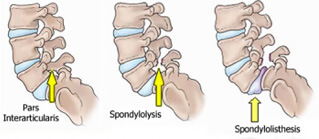Spondylolisthesis is when one vertebra slides forward on another.
Types of Spondylolisthesis
There are many types, including:
- Degenerative spondylolisthesis is a disease of older adults that develops as a result of facet arthritis and joint remodelling. Joint wear, disc collapse and ligament infolding may result in slippage of a vertebra. Degenerative forms are more likely to occur in women, persons older than fifty, and African Americans. With the slippage, the nerves in the spinal canal become compressed, causing leg and buttock pain.
- Isthmic anterolisthesis is caused by a defect within the bridge of bone between its upper and lower joints (pars interarticularis) but it can also be seen with an elongated pars. This mostly occurs as a fracture during adolescent years which mostly settles down but can, at some point, slip further and/or cause leg pain.
- Traumatic anterolisthesis is rare and results from acute fractures in the neural arch, other than the pars. An example of this is in the cervical spine at C2.
- Dysplastic anterolisthesis results from congenital abnormalities of the upper sacral facets or inferior facets of the fifth lumbar vertebra.
- Pathologic anterolisthesis is caused by either infection or a malignancy.
- Post-surgical/iatrogenic anterolisthesis is caused by complications after surgery.
Common Locations and Symptoms
It is most common at the low lumbar spine. It can be present without causing any symptoms whatsoever. In fact, about 50% or more of people who have this condition are unaware. It only requires treatment if it is causing symptoms. In the growing child, it is important that if it is detected, they are medically observed to the end of growth.
Degree of Slippage
The degree of forward slippage determines the ‘degree’ of the slip. The amount of slippage may be graded as ‘high ‘ grade or ‘low’ grade. Usually, the worse the spondylolisthesis, the more likely that it is to cause pain. This can occur early in life where the bone elongates as a result of a stress fracture, thus usually catching the L5 nerve root where it leaves the spine and causes leg pain (Isthmic Spondylolisthesis). More commonly, degenerative spondylolisthesis occurs with age and affects the nerves contained within the spinal canal (similar to spinal stenosis). Both of these types of spondylolisthesis (Isthmic and Degenerative) can affect both sides of the spine, but occasionally affect one side more than the other. Other spondylolisthesis conditions are rare, including congenital or traumatic cases.


